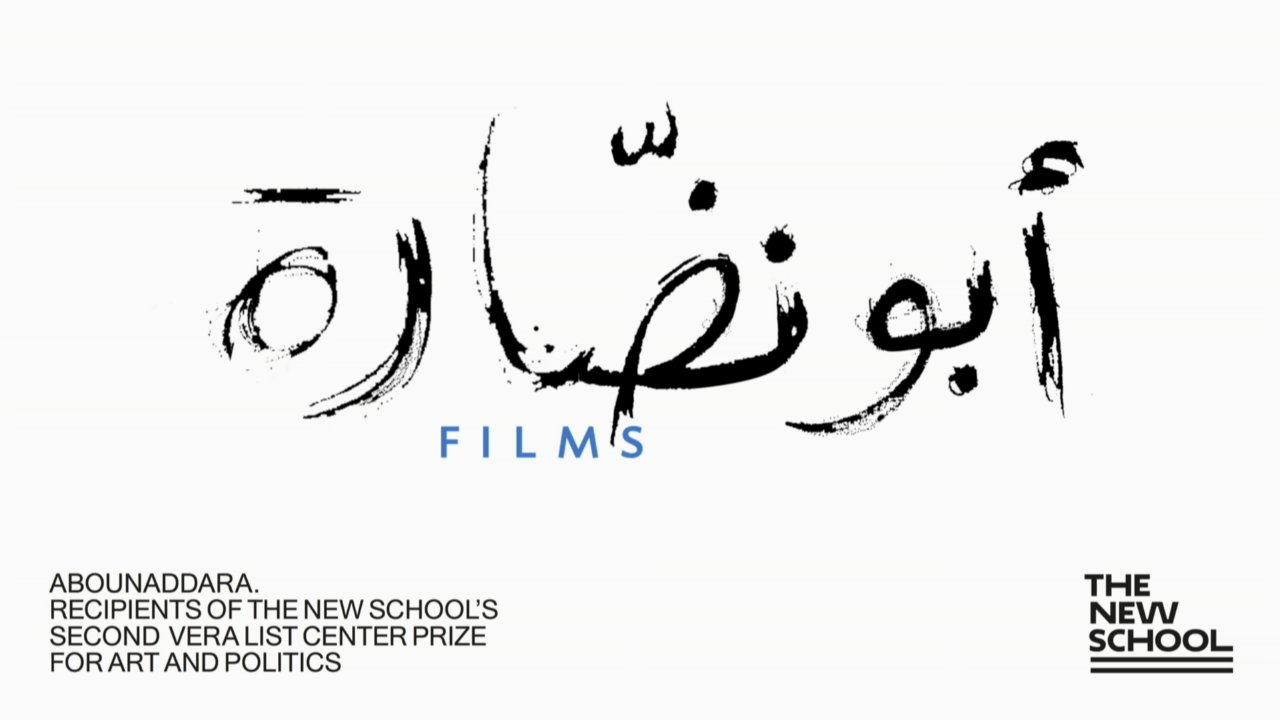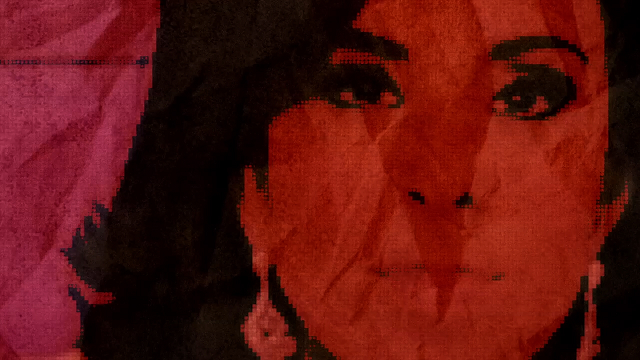
From October 22 to November 11, Abounaddara: The Right to the Image was on view in The New School’s Arnold and Shelia Aronson Galleries. Abounaddara, the anonymous Syrian film collective, was honored with the school’s second Vera List Center Prize for Art and Politics, an award granted to artists who successfully engage with or challenge the sociopolitical climates they work within. Abounaddara has, since the onset of the Syrian Revolution in 2011, released weekly “bullet films,” short videos that typically range from one to four minutes in length, that call into question the media’s representation of Syria.
The dawn of the Arab Spring brought about a series of protests against Syrian President Bashar al-Assad’s government in March 2011, followed by severe and violent government repression which eventually escalated into an on-going Civil War between multiple conflicting rebel groups and al-Assad’s forces. Since the beginning of the conflict, the Syrian government has largely restricted journalists from entering the country. Because of lack of access, foreign media has been forced to rely on the citizens of Syria to supply images of their own suffering and the wreckage of their own country. We are presented with these images on a near-daily basis, from pictures of drowned child refugees washed up on the shores of Turkey to high-definition videos of bombs detonating and destroying entire cities in a matter of seconds. In the 2014 essay “Syria: War in the Age of Televampirism,” Abounaddara argues that it is the very limitation of access that has enabled Western media to exploit the Syrian conflict for its own entertainment value. News correspondents are able to show brutally violent images of human pain, to satiate “viewers’ voyeuristic urges without having to follow journalistic, legal, or ethical guidelines.” The media is free from accountability, and is “given permission to exhibit bodies that have been murdered or humiliated for the simple reason that it is the Syrians themselves who create these images.” Thus we, as Western viewers, consume these images from the comfort of our own homes and are able to critique their content without being made to critically analyze their production and presentation.
Abounaddara works to combat this response by producing films that problematize and question Syria’s representation. The film collective strongly condemns the media’s tendency to objectify and fetishize pain and suffering, particularly when it is inflicted on brown and black people. In their work, Abounaddara argues that the images of mutilated bodies that we are constantly shown rips dignity from the victims of atrocity. Abounaddara claims that these images, because of their frequency and ubiquity, banalize war and desensitize the public to the escalating violence in Syria. While these pictures and videos do serve the purpose of alerting a distanced Western public to the dire events happening in the country, when incessantly broadcast, they produce a deadening effect and present violence as an inevitable part of life in the distant “Third World.” Shock value is no longer shocking when it is continuously used, and the media too often employs this tactic under the guise of spreading information and revealing “truth.” This representation is especially harmful and dehumanizing when it is the only representation of Syria shown on a large scale. Images of ruin are not typically paired with portraits of the lives that exist within and despite the ruin, and though we know exactly what Syrian death looks like, it is much more difficult for us to envision Syrian life. In The Right to the Image, the film collective sought to reverse the effects of these images by piecing together a holistic picture of Syria from its fragments.
The films in the exhibition were screened in a darkened room that contained four white stools and three projection screens, each showing an alteration of films running concurrently. The simultaneous screening of numerous films is overwhelming and disorienting, and necessitates multiple viewings of each screen in order for the viewer to even comprehend the videos on a basic level. The very presentation of the collective’s work represents the blizzard of information and misinformation that storms through the media in times of turmoil and tragedy, and forces the reader to take a longer look in order to see through the haze. The exhibition’s three-week run was broken up into three thematic chapters, with each week featuring a different selection of films organized around a specific strategy that the anonymous film collective employs in their work.
The first week of films was entitled “STOP THE SPECTACLE!,” and was centered around the film collective’s goal of reclaiming images of Syria from dominant media discourse. The series of films takes found footage, images, and sound, and subverts the narrative imposed on them by manipulating and editing them. The 2015 video “Kill Them!,” for example, remixes Judge Jeanine Pirro’s Fox News rant following the Charlie Hebdo shooting in January 2015. The visuals of the news clip are interspersed with video game footage of soldiers in war, overlaid with bold, pop-up text, and covered with a red filter that evokes the pop art movement of the 1950s. The use of pop art aesthetics highlights how current media practices make a spectacle of the political realm, often treating political leaders like celebrities and staging circuses around serious political events. The video’s incessant repetition of the phrases “We need to kill them” and “We need to bomb them, bomb them, and bomb them again” satirizes the Islamophobic rhetoric that spews from the mouths of the right-wing media, and extracts its meaningless and hysterical nature. The focus on the words “we,” “us,” and “them” reveals how dichotomous language is used to other and vilanize members of the Muslim community, and to simultaneously create a national identity around our relationship to this “other.” Through the remixing of news clips and sound bytes and the assemblage of media images, Abounaddara infiltrates the media by employing its tactics to critique it.

Still from “Kill Them”
The show’s second week of films, called “LOOK AT OUR FACES: PORTRAITS OF A BECOMING REVOLUTION,” were dedicated to capturing the faces and voices of the Syrian people, and reinstating the humanity taken from them by both the violence of the Syrian Civil War and the spectacularization of this violence. This tactic is most powerfully utilized in the 2014 film “Over the Toys.” The film begins with a close-up shot of Lego blocks before zooming out to the faces of Syrian children in a brightly-colored classroom. The viewer sees the children coloring, playing with toys, and singing a childhood song while their schoolteachers loom in the background, pinning up drawings to the wall and interacting with the kids. After about a minute, the video fades to a black screen with text that reads “a few miles away,” then cuts to a clip of Islamic State supporters waving flags and carrying rifles while singing a song that eerily resembles that of the Syrian children. “Over the Toys” serves the dual purpose of showing us, as desensitized Western viewers, that life goes on, even in the midst of war, and reminding us that these lives are still going on against the backdrop of violence. Rather than sensationalizing the death of Syrian citizens through images of brutalized bodies and ruined landscapes, Abounaddara, through close-ups on the faces of the schoolchildren and teachers, shows us humans who live and interact with each other, while being careful not to undermine the desperate nature of the Syrian Civil War. The film collective posits a new way of looking at tragedy: one that does not position the viewer as an objectifying, detached voyeur, but as someone who can stand alongside the subjects of this tragedy, who can engage with their humanity.
The third week of films, entitled “SEE AND WAIT,” was organized around the collective’s aim to create films that give viewers time and space to come up with their own personal interpretations, rather than immediately pushing certain narratives onto them as many news outlets do. “The Sniper,” for example, features a Syrian man sitting on a mattress in an otherwise empty room, speaking directly into the camera. The 2014 video opens with him stating, “When I end a man’s life, with a bullet, in a moment, it’s not like I’m playing PlayStation. It’s not a game.” The video then cuts to a POV video game clip of a sniper on a roof, shooting at a figure on the ground below, before bringing the viewer back into the room. The sniper continues speaking about the men he has killed in a somewhat detached tone, while the video intermittently shifts to the video game footage, which serves to place the viewer into his point of view.
After a minute and a half of this oscillation, the video game clips stop and the sniper says, “What still affects me… the death of the fetus in my wife’s womb. I cried for that.” He continues talking emotionally about his wife’s miscarriage, ending with “A human has to stay human.” The camera lingers on him sitting in silence for a few seconds before fading to black. The abrupt shift in tone in the middle of the sniper’s speech reveals to us the importance of, as Abounaddara calls it, seeing and waiting before we place judgement on characters in a certain storyline. The sniper is further humanized by the use of lighting in the film. The interview starts in black-and-white, set in a darkened room. This darkness distances us from the speaker and creates an ominous mood. As the sniper is speaking, the lights in the room turn on, making his facial features visible and restoring the color of the film. The change in lighting grounds the clip further in reality and bridges the gap between the sniper and us, the viewer.
Throughout the video, it remains unknown which side of the conflict the sniper belongs to, whether he is a member of a rebel group or of al-Assad’s army. Because this information is withheld from us, we do not view him through the lens of our own personal biases and opinions on the Syrian Civil War; we instead see him as a human being, one who happens to be deeply entangled in the conflict. This detail is representative of Abounaddara’s broader aim to not just present a singular perspective on a multi-faceted issue, but rather to construct a platform for a multitude of voices to be heard and faces to be seen. By refusing to engage within the binary structures of ally-enemy, victim-perpetrator, or spectator-spectacle, the film collective creates an in-between space for us to reach nuanced understandings and analyses of the information we are given. Rather than simply interpreting “the sniper” as a ruthless, unfeeling killer based on the first half of the video and its title alone, we are made to sympathize with him, to recognize and confront his humanity. By delaying the narrative of “The Sniper,” and by simply providing us with more narratives on the Syrian Civil War than are typically shown, Abounaddara compels us to look a bit longer before we jump into interpretations.
Note: The Abounaddara: The Right to the Image exhibition ran from October 22nd to November 11th and is no longer on view.
Written by Ana Miljak


























